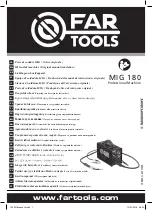
13
3.0 INSTALLATION AND ADJUSTMENT
3.1 PLANNING:
Plan your fall protection system before starting your work. Account for all factors that may affect your safety
before, during, and after a fall. Consider all requirements and limitations defined in Section 1.
3.2 ANCHORAGE:
Figure 8 illustrates Energy Absorbing Lanyard anchorage. Select an anchorage location with minimal free fall
and swing fall hazards (see Section 1). Select a rigid anchorage point capable of sustaining the static loads defined in Section
1. Where anchoring overhead is not feasible, Pro Series Lanyards may be secured to an anchorage point below the level of the
user’s Dorsal D-Ring, but must not be anchored below the worker’s feet.
3.3
HARNESS CONNECTION:
Energy Absorbing Lanyard must be used with a Full Body Harness. For Fall Arrest applications,
connect the energy absorber end of the Lanyard to the back Dorsal Attachment Element (D-Ring) on the harness (see
Figure 8). Consult the instructions included with your harness for other fall protection applications and recommended
harness connections.
Some Lanyard models are equipped with a Choker Loop that chokes on to the harness D-Ring or Web Loop (see Figure 9).
To choke the lanyard on to the Harness D-Ring or Web Loop:
1. Insert the lanyard web loop through the web loop or D-Ring on the harness.
2. Insert the appropriate end of the lanyard through the lanyard web loop.
3. Pull the lanyard through the connecting web loop to secure.Lanyard
3.4
ANCHORAGE CONNECTION:
Figure 8 illustrates connection of the Energy Absorbing Lanyard to various anchorage
options. The anchorage end of the Energy Absorbing Lanyard is configured with various Hook, Tie-Back, and Rope Grab
options for attaching to anchorage:
• Hook Connection:
Figure 8A shows connection to rebar with the Lanyard’s Rebar Hook. Figure 8B shows connection
to a Tie-Off Adapter choked around an I-Beam with the Lanyard’s Snap Hook. See Section 2 for details regarding
connector compatibility and proper connection.
;
Self-Retracting Devices:
Do not connect an Energy Absorbing Lanyard or Energy Absorber to a Self-Retracting
Device (SRD). Special applications exist where connection to an SRD may be permissible. Contact 3M Fall Protection.
4.0 OPERATION
;
First time or infrequent users of Energy Absorbing Lanyards (Lanyards) should review the “Safety Information” at
the beginning of this manual prior to use of the Lanyard.
4.1
WORKER INSPECTION:
Before each use, inspect the Energy Absorbing Lanyard per the inspection checklist in the In
spection
and Maintenance Log (Table 2)
. If inspection reveals an unsafe condition or indicates the Lanyard has been subjected to fall
forces, the Lanyard must be removed from service and destroyed.
4.2
AFTER A FALL:
Any Lanyard which has been subjected to the forces of arresting a fall or exhibits damage consistent
with the effects of fall arrest forces as described in the I
nstallation and Maintenance Log (Table 2)
must be removed from
service immediately and destroyed.
4.3 OPERATION:
Figure 8 shows system connections for typical Energy Absorbing Lanyard applications. Always connect the
Energy Absorber End of the Lanyard to the Full Body Harness first and then connect the Leg End to suitable anchorage.
See Section 3 for details regarding harness and anchorage connection.
4.4
LANYARD PARKING ATTACHMENT:
Figure 10 illustrates Harness Lanyard Parking Attachments. The Lanyard Parking
Attachment is for attaching the free end of a Lanyard Leg when not connected to an Anchorage Connection Point for
purposes of fall protection. Lanyard Parking Attachments must never be used as a Fall Protection Attachment Element on
the Harness for connecting a Lanyard (A).
When not connected to an Anchorage Connection Point, an unconnected Lanyard Leg must be properly parked on the
harness (B) or secured in the user’s hand as in 100% Tie-Off applications (C). Free hanging Lanyard Legs (D) can trip the
user or catch on surrounding objects resulting in a fall.
4.5
TWIN LANYARD INTERFACE 100% TIE-OFF:
Twin Leg Energy Absorbing Lanyards can be used for continuous fall
protection (100 % tie-off) while ascending, descending, or moving laterally (see Figure 11). With one Lanyard Leg
attached to an anchorage point, the worker can move to a new location, attach the unused Lanyard Leg to another
anchorage point, and then disconnect from the original anchorage point. The sequence is repeated until the worker
reaches the desired location. Considerations for Twin Lanyard 100% tie-off applications include the following:
•
Never connect both Lanyard Legs to the same anchorage point (see Figure 12A).
•
Connecting more than one connector into a single anchorage connection point (ring or eye) can jeopardize
compatibility of the connection due to interaction between connectors and is not recommended.
•
Connection of each Lanyard Leg to a separate anchorage point is acceptable (Figure 12B).
•
Each connection location must meet the Anchorage Requirements defined in Section 1.
•
Never connect more than one person at a time to the Twin Leg Lanyard (Figure 12C).
•
Do not allow the Lanyard Legs to become tangled or twisted together as this may prevent them from retracting.
•
Do not allow Lanyard Legs to pass under arms or between legs during use.
Содержание DBI SALA Pro Series
Страница 5: ...5 6 7 A B C 8 A B 9 1 2 3 ...
Страница 6: ...6 10 A ü B ü C D 11 12 A B C ...
Страница 7: ...7 13 14 B A B B B C 15 16 17 A B C D C C B A D E ...









































